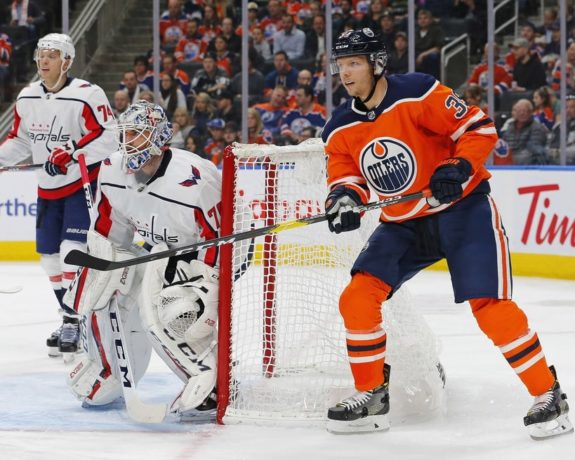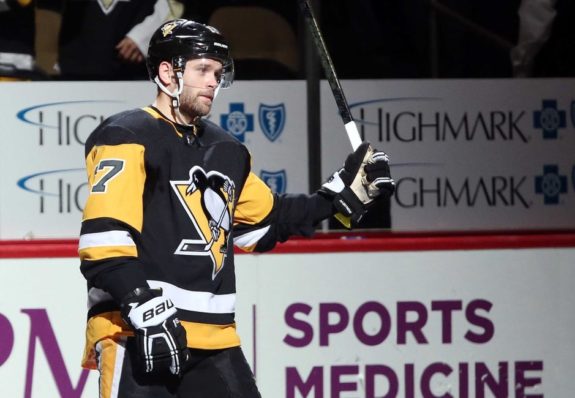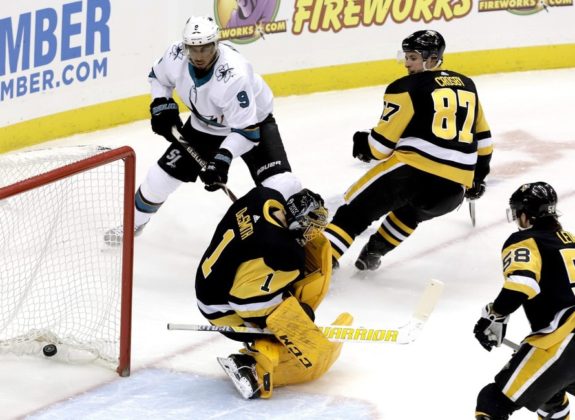Always active during deadline season, there have been rumblings that the Pittsburgh Penguins could pursue Alex Chiasson of the Edmonton Oilers as they attempt to shore up their lineup for a playoff run. While some team is going to be foolish enough to saddle up a high draft pick or a prospect for a guy who’s shooting 20 percent, it shouldn’t be the Penguins.

In 51 games this season, the 28-year-old Chiasson has 17 goals and 27 points while playing on the third line and seeing time on the Oilers’ top power-play unit. However, would acquiring him make the Penguins a better team? Probably not. There are multiple reasons why the Penguins need to avoid making a panic trade for a guy who won’t help much, but the three main reasons are a high acquisition cost, having deeper issues to solve and Chiasson’s unsustainable success this season.
Acquisition Cost Is Too High
The rumored asking price for Chiasson is a second-round pick or a good prospect. That cost is way too high for a player of his caliber, and one the Penguins should avoid in any possible way.
Starting with the picks, the Penguins don’t have a second-rounder this year because they moved it to the Florida Panthers in the Derick Brassard/Nick Bjugstad trade earlier this month. The Penguins also don’t have a 2020 second because they traded it to the Vegas Golden Knights in exchange for them taking Marc-Andre Fleury during the 2017 Expansion Draft.
That leaves the Penguins having to move one of their few solid prospects for Chiasson. Jim Matheson, an Oilers reporter for the Edmonton Journal, believes the team would be interested in asking the Penguins for prospects Jordy Bellerive, Justin Almeida, Kasper Björkqvist or Filip Hållander. Giving up any of those players in a deal that doesn’t get the Penguins a top-six forward like Mats Zuccarello of the New York Rangers or Ryan Dzingel of the Ottawa Senators would be comical mismanagement of their limited assets.

Fellow THW colleague Tyler Bowen analyzed the Penguins’ 2018 Draft and offered updates on their picks, which included Hållander and Almeida, earlier this week. Note: Almeida’s point total is now 79 in 51 games.
As for the players not covered, let’s start with Bellerive. The 19-year-old earned an entry-level contract as an undrafted free agent following a standout performance for the Penguins during the 2017 Prospect Challenge in Buffalo. So far, the returns have been promising. Following up on last season’s 92-point performance, Bellerive, who currently captains the Lethbridge Hurricanes of the WHL, has 67 points in 57 games this season, his final season of junior eligibility.
He is a fast, creative playmaker with a physical edge to his game. However, as with every young player, Bellerive has his flaws. He needs to be more disciplined, as evidenced by his 298 penalty minutes in four WHL seasons, if he’s ever going to earn the trust of the coaching staff at the higher ranks.
Björkqvist, the Penguins’ second-round choice in 2016, is in the captain of the Providence College Friars, where he has 24 points in 32 games during his third season of NCAA eligibility. The 21-year-old has earned rave reviews for his two-way play, especially his defensive zone work; and he could be ready to sign with the organization when his college season comes to an end. His blend of scoring ability and defense compares well to Bryan Rust, a current Penguin, who has been as versatile as they come since joining the roster full-time during the 2015-16 season.

If Björkqvist comes anything close to Rust, general manager Jim Rutherford would likely be kicking himself for years to come in the event he moves him for Chiasson. Or any of these players for that matter. Sure, they’ll probably all end up as middle-six forwards, but you don’t trade teenagers and players in their early 20s for fourth line rentals.
Chiasson Won’t Help With the Penguins’ Biggest Issues
With Garrett Wilson, Matt Cullen, Dominik Simon, Teddy Blueger, Jared McCann, Tanner Pearson and Zach Aston-Reese on their roster, the Penguins already have more middle and bottom-six players than they need. Chiasson also isn’t significantly better than any of these players. He may only be better than Cullen, so giving up assets and pushing a superior player out of the lineup would be counter-productive. Acquiring him also wouldn’t help the Penguins with their biggest issue: lack of identity and consistency.
No trade is going to make the Penguins more consistent. That’s a mental thing, and the fact that they’re not that good. They tend to get blasted one night and play well the next. Chiasson won’t fix that. Also, unless the Penguins completely overhaul their roster before Monday afternoon, no trade is going to give them an identity.

Back when they won consecutive Stanley Cups in 2016 and 2017, you knew the Penguins would overwhelm you with their speed and skill. For who knows what reason, Rutherford went away from that philosophy at the 2017 Draft by trading a first-round pick and Oskar Sundqvist to the St. Louis Blues for Ryan Reaves. It started two years worth of moves that made the Penguins both worse and slower. What do they want to be now? A mix of power and skill? A power team? A skilled team? Nobody knows because their style of play seems to change every game.
The Penguins primarily rely on Sidney Crosby, Evgeni Malkin, Kris Letang and Phil Kessel to do all the heavy lifting. This would be fine if it were 2014 again and they were 26 or 27 years old, not entering the later years of their careers. They have some key role pieces in Rust, Jake Guentzel, Brian Dumoulin and Justin Schultz, but the rest of the team is so wildly inconsistent that it doesn’t matter.
A more impactful move would likely be smarter lineup decisions. Everybody knows it’s not going to happen, but benching Cullen, and embattled defenseman Jack Johnson would probably improve the Penguins more than any trade they can afford to make.
His Success Is Not Sustainable
Chiasson’s shooting percentage has already fallen by 12 percent since the last time he scored on Jan. 8, and it may not be done regressing yet. Shooting 20 percent isn’t something that happens unless you’re incredibly accurate. Even Alex Ovechkin, who leads the league with 43 goals, has a shooting percentage below 20 percent — it’s at 18.1, which is a career high by nearly four percent.
Of all players who’ve taken at least 50 shots this season, Chiasson ranks eighth in shooting percentage. The players ahead of him are Elias Pettersson (23.4), Brayden Point (22.9), Tomas Hertl (22.2), Leon Draisaitl (21.8), Matt Duchene (21.4), Valtteri Filppula (21.1) and Joe Pavelski (20.3). If you notice something there, you’re not the only one. Everybody on that list, except Filppula, is a top-line talent. Chiasson, however, is not.
His ice-time would also be cut significantly as a member of the Penguins. With the Oilers and their lack of depth, Chiasson has been averaging 16:58 minutes a night, almost two more minutes than his previous career-high. He’s also averaging 2:49 per game on the man advantage, something he wouldn’t have the luxury of getting in Pittsburgh.
Chiasson’s most common linemates at all strengths this season have been Draisaitl (602:10 with) and Connor McDavid (411:30 with). He’s not getting linemates like that if he comes to the Penguins. He won’t displace Rust beside Crosby on the Penguins’ first line or Kessel on Malkin’s wing on the second line. Chaisson also wouldn’t take Patric Hornqvist’s spot beside Bjugstad on the third line. That leaves him with only an opportunity of playing alongside Pearson and Cullen on the fourth line. With all due respect to Cullen and Pearson, they’re nowhere close to the talents of Draisaitl and McDavid.

Chiasson would also be doubtful to see minutes on the Penguins’ second power-play unit despite their struggles. As the saying goes, less ice-time, especially no power-play time, with less talented players equals lower production. Especially for a guy who isn’t more than a bottom-six player by himself.
If the Penguins want to fix what’s broken, it starts from within. Not by trading for a bottom-six player who’ll likely have minimal impact on the roster. If they can get him for a late pick, it might be worth the gamble. But not if it’s going to require them to move futures that would be useful elsewhere.